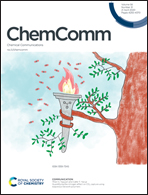Intrinsically low thermal conductivity in a p-type semiconductor SrOCuBiSe2 with a [SrO]-intercalated CuBiSe2 structure†
Abstract
Designing new semiconductors with an extremely low thermal conductivity is of considerable significance. In this study, we successfully synthesized a new semiconductor SrOCuBiSe2 with an intrinsically low thermal conductivity via the molten salt method. It possesses a typical multicomponent layered structure which is composed of alternatively stacked [CuBiSe2] (electronic conduction unit, ECU) and [SrO] (electronic insulation unit, EIU) layers. Its intrinsically low thermal conductivity (κ = 0.45 W m−1 K−1 at 700 K) is attributed to the dual effects of high atomic displacement parameter and extremely large Grüneisen parameter, which are caused by rattling vibration of Cu atoms and lone-pair electrons of Bi atoms, respectively. Such knowledge highlights the importance of lone-pair electrons in impelling the phonon anharmonicity and multicomponent structure design concept, providing a stepping stone to the design of new semiconductors with a low thermal conductivity.
![Graphical abstract: Intrinsically low thermal conductivity in a p-type semiconductor SrOCuBiSe2 with a [SrO]-intercalated CuBiSe2 structure](/en/Image/Get?imageInfo.ImageType=GA&imageInfo.ImageIdentifier.ManuscriptID=D0CC00035C&imageInfo.ImageIdentifier.Year=2020)


 Please wait while we load your content...
Please wait while we load your content...